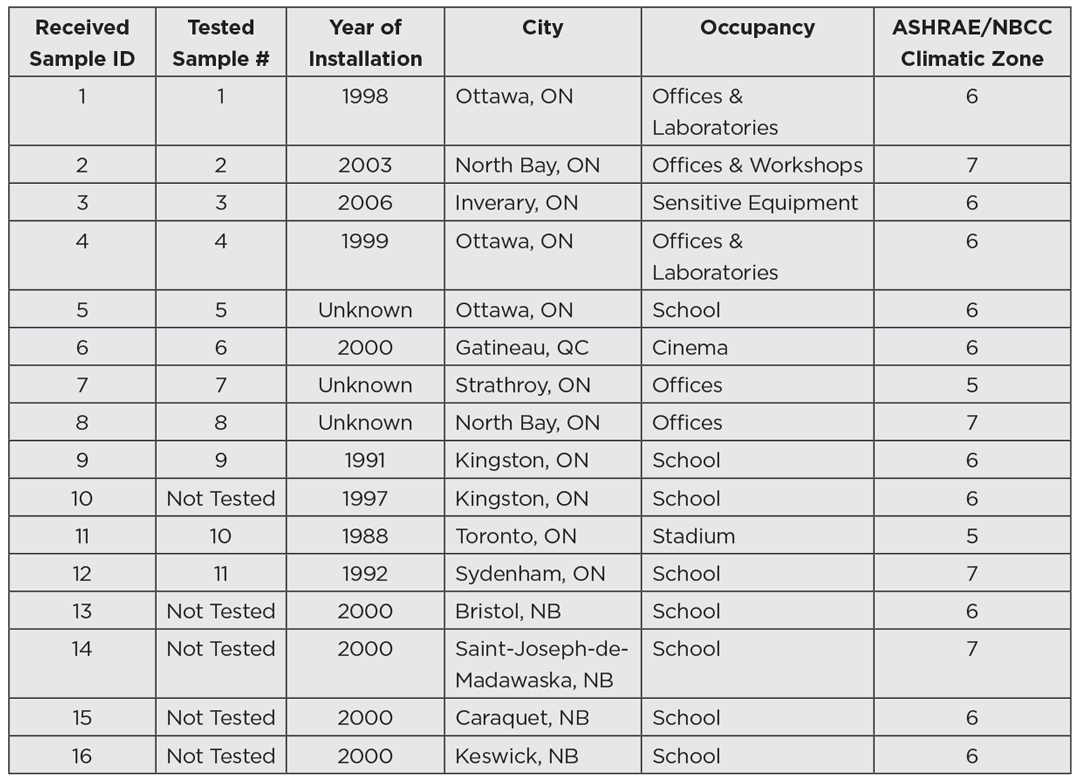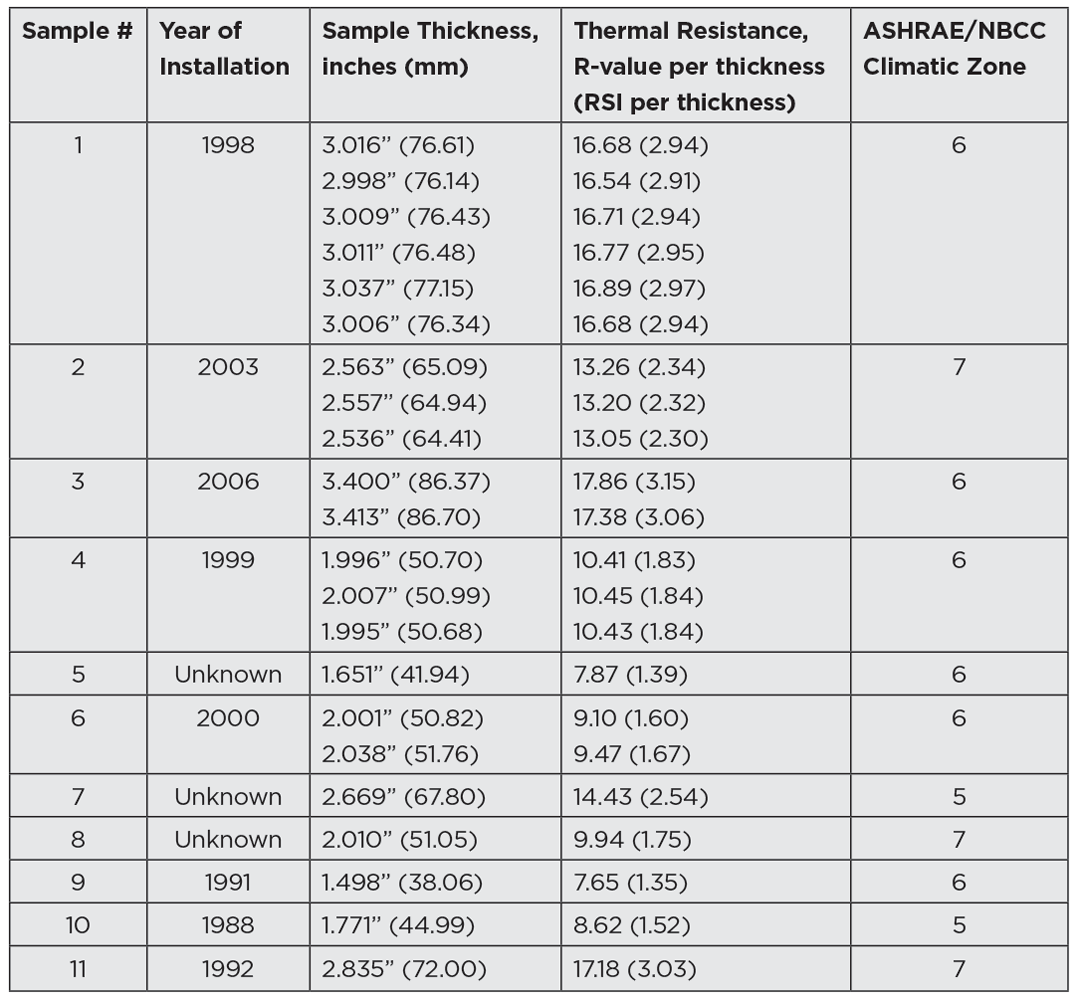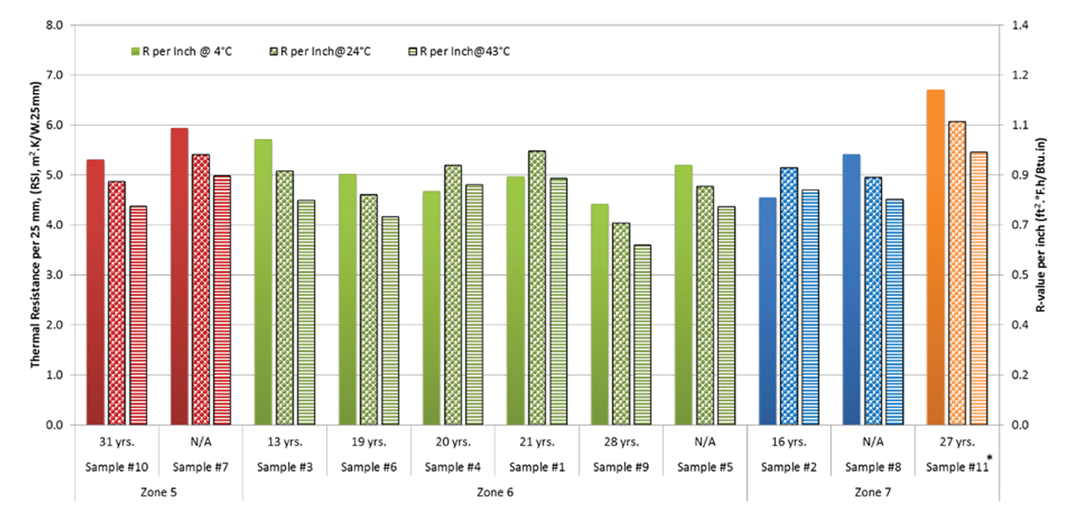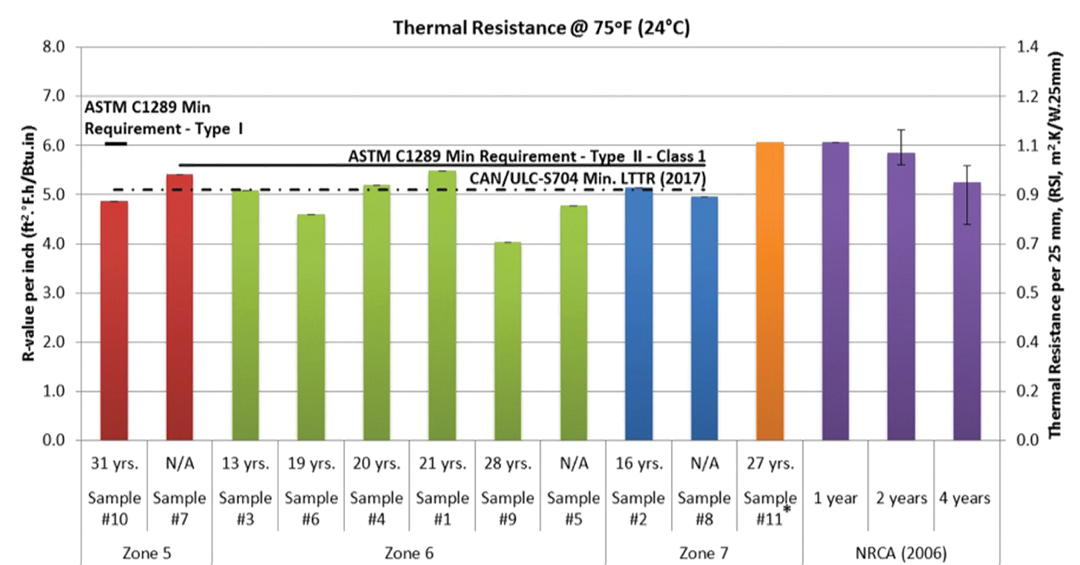Authors’ note: Fishburn Sheridan & Associates Ltd., Kanata, Ontario; Dean-Chandler Roofing Ltd., Scarborough, Ontario; and Daniel Theriault Roof Inspection, Edmonton, New Brunswick, collected and provided the insulation samples. Helen Yew and David Van Reenen, NRC technical officers, assisted in conducting the experiments.
Commercial roof systems represent vast surface areas of building envelopes, and the rate of energy transfer across these roofs influences buildings’ holistic energy performance. Thermal insulation affects this energy transfer, and obtaining accurate thermal resistance values (R-values) for insulation products is essential for specifying heating and cooling loads, HVAC equipment and the long-term energy use of building envelopes.
Polyisocyanurate is the predominant insulation material used in commercial roof systems in North America. It has a higher R-value per thickness compared with other common insulation materials. Polyisocyanurate is a closed-cell insulation material that contains a blowing agent within its cells to reduce the rate of heat transfer. Similar to other blown insulating foams, the blowing agent diffuses over time, resulting in a change in R-value. This change in R-value is known as thermal drift.
LTTR
To determine thermal drift, the concept of long-term thermal resistance was introduced in the 1990s through research conducted by Oak Ridge National Laboratory, Oak Ridge, Tenn., in cooperation with NRCA, PIMA and The Society of the Plastics Industry. Standards have been developed to measure LTTR using an accelerated aging slicing and scaling method where thin slices of foam specimens are used to accelerate gas diffusion, resulting in a reduction of thermal resistance that represents insulation’s aging process. LTTR represents a 15-year time-weighted average of the insulation’s R-value derived from five years of relative aging. It is noted this accelerated aging method occurs under laboratory conditions.
Knowing the LTTR of insulation enables roof system designers and roofing contractors to determine the actual thickness of the insulation required to meet building codes and estimate the long-term energy performance of a roof assembly. However, minimal studies have validated laboratory methods by investigating in-service aging of insulation. Some studies provided insight into the knowledge gap and confirmed additional research is needed to correlate the effects of aging with the laboratory predictions and requirements in the current standards.
Previous studies
For example, in 2006, NRCA conducted a limited study on the aging of polyisocyanurate insulation. The study, conducted with the Canadian Roofing Contractors Association and Extruded Polystyrene Foam Association, consisted of 20 specimens that were aged naturally in laboratory conditions for less than five years. The study found 17 of the tested specimens exhibited R-values less than their established LTTR values, demonstrating LTTR methodology appears to overestimate a product’s actual R-value at five years of relative aging.
In 2009, a field monitoring study was conducted by RDH Building Science Inc., Vancouver, in collaboration with the Roofing Contractors Association of British Columbia to obtain information regarding concerns of aging polyisocyanurate insulation. A building was set up to record the temperature-dependent conductivity of the insulation over 5 1/2 years. The in-service results were compared with samples that were aged naturally in laboratory conditions at 72 F. The study concluded in-service aged polyisocyanurate insulation measured less thermal resistance than lab-aged polyisocyanurate insulation.
Another study was completed by RDH Building Science in 2015 during which three-year-old polyisocyanurate specimens were removed from the roof of a building in British Columbia and tested in a laboratory. The in-service aged results were compared with the same insulation tested when it was a new material, and it was determined the aged insulation had a significantly reduced R-value—up to 25% at low mean temperatures compared with the new insulation—demonstrating the effects of the initial aging on the material’s performance.
These limited studies confirmed additional investigation is needed to correlate the effect of aging with the predictions and requirements in current standards. Furthermore, additional exploration of in-service aging through exposure to typical climatic events in roof assemblies is required to gain a better understanding of the effects of in-service conditions on polyisocyanurate thermal performance. Additional properties, such as compressive strength and flexural strength, also require investigation to determine the effect of aging on the critical mechanical properties of polyisocyanurate insulation.
New study
To validate and further continue the research of earlier studies, the National Research Council Canada is conducting a study to quantify the effects of aging on thermal insulation materials. The study supports NRC’s ongoing initiative of climate resiliency and adaptation of building envelope materials and designs. The study involves collecting in-service polyisocyanurate samples and will be further expanded to other common roof insulations. We have some experimental data from the analysis of thermal and mechanical properties of aged polyisocyanurate insulation boards and can provide a relative comparison with code and standard minimum requirements.
NRC obtained polyisocyanurate samples from 16 roofs that were being retrofitted or re-covered. The samples were collected from buildings with variable occupancy in New Brunswick, Ontario and Québec. The exposure period ranged from 13 to 31 years. The insulation samples retrieved from the 16 roofs were a combination of one-layer boards, two-layer adhered boards and insulation boards with adhered cover boards.
Excluding the boards from the third category, 11 samples were investigated. The samples, their years of installation and occupancy types are in Figure 1. The samples were grouped according to ASHRAE climatic zones based on the locations of their buildings.
 Figure 1: Year of installation, city, occupancy and ASHRAE climatic zone of polyisocyanurate insulation samples collected
Figure 1: Year of installation, city, occupancy and ASHRAE climatic zone of polyisocyanurate insulation samples collected
All the collected insulation boards had organic felt facers that fall into the category of Type II except sample 12, which was Type I with an aluminum facer. This classification is based on ASTM C1289, “Standard Specification for Faced Rigid Cellular Polyisocyanurate Thermal Insulation Board.”
Once the samples were obtained from the test sites, they were not further conditioned in the laboratory because the objective was to evaluate the insulation in its current state. Test specimens were prepared from the obtained samples, and they were evaluated for R-value, compressive strength and flexural strength.
R-value
R-value is determined by creating a steady-state temperature difference across the insulation that induces a unit heat flux. The R-values of the aged specimens were evaluated using a heat flow meter according to ASTM C518, “Standard Test Method for Steady-State Thermal Transmission Properties by Means of the Heat Flow Meter Apparatus.” The specimen size used for the heat flow meter evaluation was either 12 by 12 inches or 24 by 24 inches. Following the methods prescribed in ASTM C1289, the specimens were tested at mean temperatures of 40 F, 75 F and 110 F with a temperature differential of 40 F.
A sample’s R-value was determined by averaging the R-values obtained from individual specimen testing. The number of specimens evaluated varied based on the insulation received. The R-value was evaluated on the full thickness specimens, and the R-value per inch was calculated. Figure 2 shows the measured thermal resistance of the full-thickness specimens tested at a mean temperature of 75 F.
 Figure 2: Thermal resistance of tested specimens
Figure 2: Thermal resistance of tested specimens
Figure 3 shows the average R-value per inch determined for each sample. The R-values are grouped by climatic zone and then presented in increasing order of age with the lowest age of insulation on the left-hand side and the highest age of insulation on the right-hand side. Several samples had an unknown age, denoted by N/A, and were, therefore, placed on the right-hand side.
Note the performance of polyisocyanurate insulation varies depending on several factors, including insulation brand, material formulation, blowing agent type and facer type.
Blowing agents used by manufacturers have been reformulated multiple times as a result of environmental restrictions. Previous blowing agents included CFC-11 and HCFC-141B; however, since 2002, the industry has used hydrocarbons such as pentane as the blowing agent. Each manufacturer has a different formulation, and each blowing agent has unique properties that determine the performance of the insulation.

 Figure 3: Average R-value per inch of samples evaluated at three mean temperatures of 40 F, 75 F and 110 F
Figure 3: Average R-value per inch of samples evaluated at three mean temperatures of 40 F, 75 F and 110 F
Furthermore, the thermal performance of polyisocyanurate insulation varies as a function of age and temperature. The focus of the comparison was not to identify the manufacturers or the blowing agents of the samples but to investigate the insulation performance as a generic component independent of manufacturer details. The effect of age on the thermal performance of aged polyisocyanurate insulation was analyzed to determine the changes that occur in-service over time.
In Figure 3, the measured data shows sample 9, which aged for 28 years, measured the lowest thermal resistance (R-4 per inch) while sample 1, which aged for 21 years, measured the highest thermal resistance (R-5.5 per inch). Because of blowing agent and manufacturer formulation variables, no clear relationship could be established between insulation age and R-value.
The resulting R-values were compared with the ASTM C1289 minimum thermal resistance requirements and CAN/ULC-S704, “Thermal Insulation, Polyurethane and Polyisocyanurate, Boards, Faced” minimum LTTR value to provide a point of comparison.
At a mean temperature of 75 F, ASTM C1289 provides an R-value per inch of insulation thickness of 5.6 ft2.°F.h/Btu.in and 6.0 ft2.°F.h/Btu.in as the minimum required thermal resistance for Type II, Class 1 and Type I insulation types, respectively. The thermal performance of the aged samples was below this requirement, which was expected. The ASTM C1289 test protocol is for reporting the thermal resistance measurements of new boards that have undergone an early stage of aging. This early-stage loss of R-value is based on preconditioning foam samples at room temperature (75 F) for 180 days before R-value testing at the mean temperatures of 75 F. However, for comparison purposes the R-value of the in-service aged boards was 3% to 30% lower than the minimum requirements of new insulation boards.
A similar comparison was made in Figure 3 with the CAN/ULC-S704 minimum thermal requirements. These requirements are based on LTTR testing reported at 75 F where the loss of insulation R-value is dominated by blowing agent diffusion. CAN/ULC-S704 provides a minimum LTTR value of 10.21 ft2.°F.h/Btu for 2-inch-thick insulation. Normalizing to 1-inch-thick insulation, the predicted LTTR value is 5.2 per inch, which is plotted in Figure 3 as the point of comparison for Type I and II aged insulations. The comparison in Figure 3 indicates five out of the 10 samples that are close to 15 years and 20 years of field aging are close to this minimum requirement. Although this comparison doesn’t shed much light on the relation between published LTTR values (as it is not known for the samples) and actual aged five-year measured R-value, the data show there is a possibility the five-year actual R-value of the five samples must have been greater than R-5.2 and then tapered off over time.
Figure 3 also compares NRCA test data representing the average thermal resistance of aged insulation boards (one, two and four years) that have been aged in controlled laboratory conditions. The error bars over the two- and four-year samples in Figure 3 provide the range of the measured data from the tested samples.
The intent of the NRCA test data was to demonstrate R-values of insulation boards that have undergone aging for less than five years were less than the published LTTR values. Based on these observations and also from the realities that rooftop temperature conditions vary significantly from LTTR-prescribed laboratory conditions, NRCA does not view LTTR as being representative of design R-value. NRCA recommends using an R-value of 5 per inch in heating-dominated climatic zones for the purpose of roof thermal design. Seeing the thermal performances of aged in-service boards in Figure 3, especially samples 2 and 3 that are close to the LTTR time average period of 15 years, the roofing industry should give some thought to NRCA’s recommendation.
Figure 3 shows the temperature dependency performance of the aged insulation samples. Except for samples 1, 2 and 4, the samples showed linear thermal performance (decreasing R-value with increasing mean temperature). Two assumptions can be made from this linear thermal performance: the blowing agent response to temperature and the replacement of blowing agent with air.
The temperature-dependent thermal performances of samples 1, 2 and 4 were different from the other samples. The data from these samples show an inverted crown profile (maximum R-value at the mean temperature of 75 F and lower R-value at the mean temperatures of 40 F and 110 F). This profile is typical of insulations blown with hydrocarbons and pentane, which are susceptible to condensation at colder temperatures. But what is interesting is that though these samples have been in service for 20 years, they have not shown linear aging characteristics similar to the other samples.
With respect to the influence of temperature, one of the missing pieces of information in these field-obtained samples is the location of the insulation within the system. For example, was it a one- or two-layer insulation layout, and if it is a two-layer layout, was the insulation sample the top or bottom layer? With all these influencing parameters, this variation in the results among the different aged insulations should be expected.
Compressive strength
The compressive strength of the polyisocyanurate insulation specimens was tested in accordance with ASTM C1289, which refers to a test method in ASTM D1621, “Standard Test Methods for Compressive Properties of Rigid Cellular Plastics.” To determine compressive strength, five 2- by 2-inch specimens were evaluated. The specimens were placed between compression plates, and the crosshead compressed the specimen at a constant speed equal to 10% of the specimen thickness per minute ± 0.01 inches per minute. The test was conducted until the specimen had been compressed to about 13% of its original thickness as specified in the standard to determine the load applied at 10% deformation.
It is noted compressive strength and flexural strength testing was completed on remaining material after producing the R-value specimens. Therefore, based on the quantity of insulation received, compressive strength and flexural strength evaluations were not possible on all samples.
The averages of the individual specimens were compared with ASTM C1289 to verify the minimum requirement for the compressive strength of faced rigid cellular polyisocyanurate thermal insulation boards.
The minimum requirement is 16 pounds per square inch for most board types excluding higher grades and Type II, Class 4, which is a high-density polyisocyanurate board faced with coated or uncoated fiberglass mat facers on both major surfaces of the core foam and used at a maximum thickness of 1/2 of an inch. All boards tested, with the exception of sample 6, surpassed the minimum requirement. The overall results indicate the in-service aging process did not lower the compressive strength below the current requirements even after 13 to 20 years of aging in roof assemblies.
Flexural strength
The flexural strength of the samples was tested in accordance with ASTM C203, “Standard Test Methods for Breaking Load and Flexural Properties of Block-Type Thermal Insulation,” Method 1, Procedure B. If sufficient material was received, four specimens were cut from the sample, two from each direction. When insufficient samples were received, only two specimens were cut from the same direction. Specimens were 3 inches by 12 inches. During the test, the load was applied to the specimens at a constant rate of 0.1 inch per minute per 1 inch of thickness.
All samples surpassed the minimum requirement for breaking load of the current standard of 17 pound-force for all types and classes, excluding Type I, which is faced with both major surfaces of the core foam, and Type II, Class 4. The breaking loads then were used to calculate the flexural strengths, which were normalized for the specimen thicknesses.
Most of the samples tested, with the exception of sample 6, met the current requirement of a minimum flexural strength of 40 psi for all polyisocyanurate types except Type II, Class 4. The oldest specimen tested for flexural strength was specimen 4, which was aged for 20 years in-service and surpassed the existing flexural requirements. These results suggest that even after 13 to 20 years of aging naturally in-service, the flexural strength of polyisocyanurate surpassed the current requirements for most samples, maintaining sufficient flexural properties.
Analysis
We analyzed the R-value of in-service aged polyisocyanurate insulation samples recovered from low-slope membrane roofs that were undergoing retrofit or replacement. Although conclusions cannot be drawn regarding the thermal drift of the aged samples and their relation to predicted LTTR values, their thermal performances showed 50% of the collected samples measured an R-value of 5 per inch or more even after being exposed to field conditions for 13 or more years.
The in-service aged polyisocyanurate insulation samples also were tested for mechanical properties by evaluating the compressive and flexural strengths. All samples tested, with the exception of one, surpassed the current minimum requirement for compressive strength. Similarly, all but two samples met the current flexural requirement, maintaining sufficient flexural properties. The study revealed that though there are changes that occur within polyisocyanurate insulation as a function of age, a majority of the samples retained reasonable performance.
Future investigations that would provide essential information include quantifying the effects of moisture on aging polyisocyanurate insulation, a composition analysis to quantify the rate of blowing agent diffusion and an investigation of the effect of temperature shocks on the long-term thermal performance of polyisocyanurate insulation.
Sudhakar Molleti is a senior research officer at the National Research Council of Canada; Bas Baskaran is a group leader at NRC; and Dominique Lefebvre is a former research officer at NRC.
COMMENTS
Be the first to comment. Please log in to leave a comment.